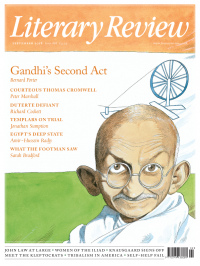Daisy Dunn
Minotaur She Wrote
Red Thread: On Mazes & Labyrinths
By Charlotte Higgins
Jonathan Cape 216pp £25
When the wife of King Minos of Crete developed an unhealthy passion for a bull, she clambered inside a mechanical cow fashioned by the craftsman Daedalus and promptly conceived the Minotaur. The monster was placed inside a labyrinth of Daedalus’s design and fed a tribute of Athenian youths once every nine years until, finally, Theseus arrived and killed it. The king’s daughter, Ariadne, fell for this stranger and gave him the thread he needed to wind his way out of the maze. Theseus repaid her by abandoning her while she slept.
Sir Arthur Evans described Knossos on Crete as ‘at once the starting point and the earliest stage in the highway of European civilisation’. The incredible Bronze Age remains of King Minos’s ancient kingdom sparked Charlotte Higgins’s fascination with labyrinths and, in particular, the myth of the Minotaur, which forms the central thread of her book. In the early pages she recalls visiting the site as a child and meeting museum guide Mrs Sofia Grammatiki, who gave her some postcards. After university, she writes, she stumbled upon the address of the inspiring museum guide, who became her pen pal and muse.
The labyrinth or maze – there is no strict rule for distinguishing one from the other – is an attractive conceit, especially for a writer. There must be a point at which the author of every book longs to define their work as a labyrinth. Threads left dangling? Intentional. Dead

Sign Up to our newsletter
Receive free articles, highlights from the archive, news, details of prizes, and much more.@Lit_Review
Follow Literary Review on Twitter
Twitter Feed
Although a pioneering physicist and mathematician, Blaise Pascal made it his mission to identify the divine presence in everyday life.
Costica Bradatan explores what such a figure has in common with later thinkers like Kierkegaard.
Costica Bradatan - Descartes Be Damned
Costica Bradatan: Descartes Be Damned - Blaise Pascal: The Man Who Made the Modern World by Graham Tomlin
literaryreview.co.uk
The era of dollar dominance might be coming to an end. But if not the dollar, which currency will be the backbone of the global economic system?
@HowardJDavies weighs up the alternatives.
Howard Davies - Greenbacks Down, First Editions Up
Howard Davies: Greenbacks Down, First Editions Up - Our Dollar, Your Problem: An Insider’s View of Seven Turbulent...
literaryreview.co.uk
Johannes Gutenberg cut corners at every turn when putting together his bible. How, then, did his creation achieve such renown?
@JosephHone_ investigates.
Joseph Hone - Start the Presses!
Joseph Hone: Start the Presses! - Johannes Gutenberg: A Biography in Books by Eric Marshall White
literaryreview.co.uk